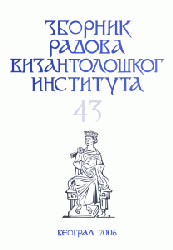Kalendari srpskih rukopisa prve polovine XV veka
Calendars of the Serbian Early 15th Century Manuscripts
Author(s): Tatjana Subotin-GolubovićSubject(s): History
Published by: Vizantološki institut SANU
Keywords: manuscripts; 15th century; church; hagiographic texts; monastery;
Summary/Abstract: Within the corpus of Byzantine manuscripts, a prominent place is occupied by synaxaria, collections of texts in which hagiographic material is arranged according to the calendar order. The differences among such collections are to be noted in the structure, composition and size of the texts included. The existence of text collections in which early hagiographies are compiled and partly codified can be traced back into the 6th to 7th centuries. The principle center of agglomeration and codification of this type of materials used to be Constantinople. The older type synaxaria, known as prolog in Slavonic tradition, authored by Constantin from Mokissa, have been preserved in relatively large numbers of Southern Slavic transcripts. The prologs of the newer type, the so called "verse prologs" (regularly preceded by a few short verses), might have been translated, according to the opinion of D. Bogdanovic, as early as the end of the 13th century, and in the Serbian environment. This opinion is corroborated by the fact that the oldest hitherto preserved prologs of this type, dating from the 14th century, were written in the Serbain redaction of Old Church Slavonic. Bogdanovic's studies of prologs is based on manuscripts from the monastery of Decani. A relative abundance of verse prologs is treasured in the library of the monastery of Chilandar. Introduction of the new type of prolog has undoubtedly been caused by the introduction of the Jerusalem typicon into the liturgical practice of the Serbian church. Occasionally, hagiographic texts used to be inserted into menaion acolouthia after the sixth ode of the canon. Presently the oldest Serbian menaion containing hagiographies of the new type is the MS nr. 11 from the Archives of the Serbian Academy of Sciences and Arts, written sometime around 1400 A.D. Thus menaia also include multiply augmented hagiographic materials. The comparative analysis of prologs and menaia for the months of July (MS Decani 53, Pec 42, Chilandar 426) and August (Decani 43, Pec 42, Decani 53) has shown that texts from verse prologs used to be incorporated into menaia practically unaltered.
Journal: Зборник радова Византолошког института
- Issue Year: 2006
- Issue No: 43
- Page Range: 175-189
- Page Count: 14
- Language: Serbian

